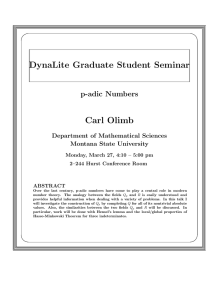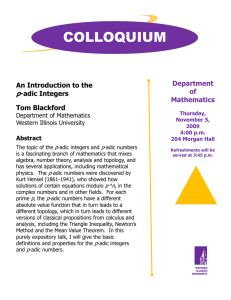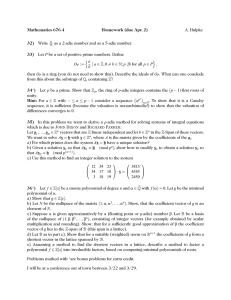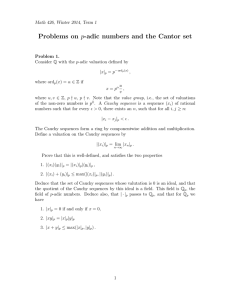N. JAYARAM* S. K. SEN
advertisement
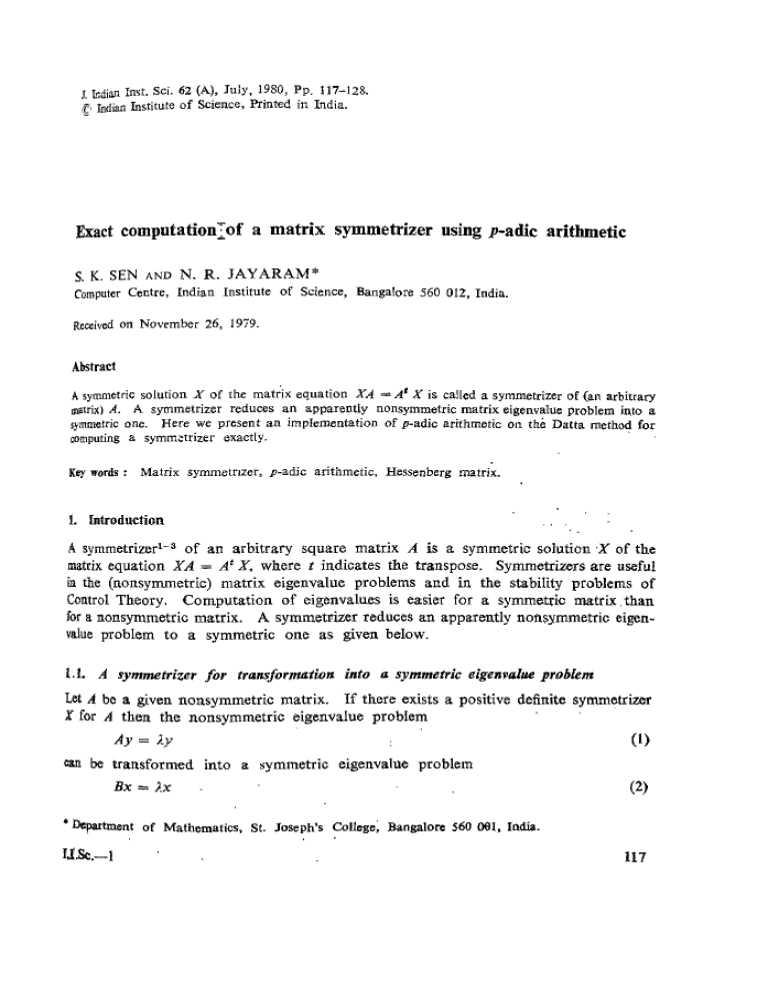
j.
bdim Inrt. Sci. 62 (A), July, 1980, Pp. 317-128.
hdian Institute of Science, Printed in India.
S. K. SEN
AND
N. R. JAYARAM*
Computer Centre, Indian Institute of Science, Bangalore 560 012, In&a
Received on November 26, 19i9.
Abstract
A symmetric solution X of the mathx equation XA =A' X is called a symmetrizer of (an arbitrary
~xrix)A. A symmetrizer reduces an apparently nonsymmetric matrixeigenvalue problem into a
r,mmetric one. Here we present a n implementation of p-adic arithmetic on the Datta method for
mmputing a symm2trizer exactly.
Ke words :
Matrix symmetruer, P-adic arithmetic, Hessenberg matrix
1. Introduction
A syrnmetrizer'-2 of an arbitrary square matrix A is a symmetric solution .X of the
matrix equation XA = At X, where t indicates the transpose. Symmetrizers are useful
in the (nonsymmetric) matrix eigenvalue problems and in the stability problems of
Control Theory. Computation of eigenvalues is easier for a symmetric matrix than
for a nonsymmetric matrix. A symmetrizer reduces an apparently nonsymmetric eigenvalue problem to a symmetric one as given below.
1.1. A symmetrizer for fronsformtwn into o symmetric eigenvalue problem
kt A be a gweu nonsymmetric matrix. If there exists a positive definite syrnmetrizer
X for A then the nonsymmetric eigenvalue problem
(1)
Ay = 2y
be transformed into a bymmetric elgenvalue problem
Bx = I x
*-menf
1dSc.-1
(2)
of Mathematics, St. Joseph's College, Bangalore 560 081, India.
,
.
117
118
S. K. SEN AND N. R. JAYARAM
as shown below:
From (1)
cy = a x y
where C = XA. Now X = S'DS where St = S-I and D is diagonal.
Let G = SCS' and F = Sy. Then
GF = SCS' Sy = SCy = IDF.
If d,, > 0 for all i then we have D = D: for some Dl.
GF = 1D1DlF or D;' GF = 1D,F or D;' GD;'D,F
Let D;I GD;' = B and D,F = x. Then (1) becomes
Bx
= Ax
14)
Thus we have, from (4),
=
ADIF.
(9
where B is symmetric and real.
1.2. Symmetrizer for computing zeros of a poIynomial
A syrnmetrizer can be used to obtain the roots of a polynomial equation4.:. M
s is
achieved by symmetrizing the companion matrixS of the polynomial and then corn*
ing its eigenvalues by a matrix method.
1.3. Existence of a symmetrizer
There always exists a symmetrizerl for a nonderogatory matrix A. An n x n matrix
is maderogatory if and only if its characteristic polynomial (which is of degree d
is the same as its minimum polynomials.
1.4. Transfoormation info ~esseabergform
An arbitrary nonsymmetric matrix A can be transformed into a lower Hessenberg
forms,8 B ( A and B having identical eigenvalues since the transformation is of similarity type). It is assumed that B has nonzero codiagonal. This assumption does
reduce the generality.
1.5. Algorithm and arithwtic used
Ib&d and Farcells were the fist t o propose a numerical procedure (though not
smble in general) for computing a symmetrizer of an arbitrary matrix. Here we con.
si&r an algorithm due to Datta2 for computing a symmetrizer of a real matrix (lowa
Hessenberg).
It is important to obtain an error-free symmetrizer. Often numerical in*biiig
of an algorithm used and errors involved for a given matrix are beyond toleram
Here we employ p-adic arithmetic7.8 for error-free computation of a symmetrizer
describe it for convenience. A criterion for the selection of a prime base P and
number of digits r t o be involved in representing a quantity (in p-adic form) is m i
'
'
MATRIX
SYMMETRIZER
USING
P-ADIC
ARITHMETIC
119
we
describe the computation of the global denominator. Its knowledge is
,mssary for converting p-adic output t o rational output. It is interesting to note that
in the Datta method of symmetrization of a n integer (Hessenberg) matrix the global
denominatorundergoes no modification even during p-adic m ~ l t i p l i c a t i o n / d i ~ i ~ i ~ ~ .
z
Steps for exact computation using p-adic arithmetic
kt there be a numerical problem that involves a finite number of arithmetic operations.
Since a digital computer works with finite length numbers in n-ary scale where n is any
positive integer (say 10) called the radix or base, our input data are always rational
numbers. We assume the rational input data to be exact.
step 1. Choice of prime base p and number of digits r . Choose a prime base p and a
positiveinteger r such that the largest magnitude number (that arises while executing
a numerical algorithm for solving the said numerical problem) is less than or equal
to ,/((p' - 1)/2). The condition is sufficient.
Remarks : (i) This allows a negative number to be represented in complement form
uniquely.
(i)
Choice of p and r depends on the given numerical problem and the algorithm
to solve it.
(iii) Step 1 requires a method to be devised t o obtain a small (preferably the smallest)
number greater than or equal to the largest magnitude number (which the algorithm
produces).
Step 2. Store the p-adic from of (a positive integral multiple of) the LCM of the
denominators (positive) of all the input rational numbers in a location called Global
Denominator ' GLODEN '. Encode all the input rational numbers (both negative and
pnsitive, assuming a negative sign is attached to a numerator only) to p-adic numbers.
Remark : Since the denominator is a positive integer, its p-adic representation has an
axponent zero.
St@p 3. Execute (using the p-adic arithmetic) the numerical algorithm whose input
data are: (i) the p-adic numbers and (ii) the GLODEN. Update the GLODEN, if
m s a r y , whenever there occurs a p-adic mnltiplication/division.
Renarks : (i) In a p-adic addition/substraction GLODEN remains unchanged.
(li) For the modification of the GLODEN a knowledge of the denominators d the
w d s is essential. Since the operations are performed in p-adic arithmetic, the
denominators are not explicitly known. Therefore, whenever a modification of the
GmDEN is required, the operands must be converted to their rational forms using
current GLODEN.
Step 4. Decode the p-adic output to rational form using the GLODEN.
!20
S. K. SEN AND N. R. JAYARAM
2 . 1 . Encoding ~,atiunakinput fo p-a:&c &at
(Step 2)
.
Let p and r be known from SLep 1 . Alw, let the usual symbols (like +, -, , j i ,i
real arithmetic be the symbols for p-adic opcrdtions (add, subtract, multiply,divide,
as long a5 operands are p-adic numbers.
.Sub.~bsrc.p2. GLODEN +-p-adic form of the LCM. [Let the LCM be q,. rhzn its
= i tilr;
p-adic form is .s,s, . . . s, ~ l l e r c r, = poiitive remeindor of q,., t pi ,
l (1) r - 1.i
(0 < s, < p). q, = pssitivi? quotient of q,-, + p , i
-
substep 3. Convert the numerator and the denominator of each rational inpu! into
form in the same way as ill Substep 2. if tile numerator has a negative sign
then consider, for the numcraLor, its colnpkmWIt, vii., " p ' n u m e r a i o r " before con.
Divide the p-adic numerrtor by the p-adic deilon~inatorusing p-adic division
(ses p-adic arithmetic See. 2.3).
The input data are rhus (i)the p-adic form of all rational input data, and [ii,
the GLODEN.
NO~L,:
2.2.
Updating .gJobnl denominator GLODBN (Step 3)
p-adic addition/subtraction (+/-) do not alter the Global Denominator GLODEN.
p-adic multiplication/division, however, may alter tht: GLODEN.
For each integer a, where 0
< a < pr - 1:
define
u ( a ) - a i f ~ < a < g A, v ( a ) = a - p ' i f g l 2l < a < p ' - - i .
Also. for each mantissa part m,
=
.s,s,
.. .
s,
of a p-ddic nunlbcr
I (m,, = 'y s,p'.
(i) GLODEN after a multipliration : Let
number$ to be multiplied. Compute
a =
1
PC'
G
Compute
(I(mp GLODEN))]
~
=
I
p4e-
I (GLODEN)
N
a' = GCD (6, ~
fl+ = GCD @, G
define
and fj = mpEe,9 be two p-adit
ma&,
ii = [u (I (ma. GLODEN))] -= [ti
m,Ee.
(2
i=z
fi
a =
(6)
i
m
~
)
)
G = GCD ( G m N I a + , CX~E%N/,~'+).
.MATRIX SYMMETRIZER USING P-ADIC ARITHMETIC
L
f =~ 1
then GLODEN does not alter. Otherwise, GLODEN
6
121
GLODENY p.adic form
sf G.
,pmi&s :
.
( a ) GLODEN/a+ is the denominator of
a.
( b ) BG
'N
,-/
8.
is the denominator of
tiii GLODEN @er. a division : Let a = m,Ee, and
is :O be divided by P. Here
GLODEN
t
p,
G-,
0 = !ngEeg be twu p-adic numbers.
p/p)
p-adic form of LCM ,G
-(
/j-
are ns defined in
(I)
(10)
of Sec 2 2.
2.3. p-adic ariihmelic (Steps 2 and 3)
usual symbols like + , - : . , / r e p w m t respectively the p-adic add, subtract,
;nuitiply, and divide operations, as long as the operands are p-adic numbers. Let
52 three p-adic numbers where nl,, mg and n?, are mantissas and e,, e6, ey are exponents. Also, let p be the prime base and r be the number of digits rztained in a
mantissa.
{i) p-odic addition ( y = a
+ fi)
: Let
Shift s,s' by r, = e, - ep places to the left. Then carry out p-adic addition on these
mantissas in the same way as in the finite field arithmetic with prime base p. The p-adic
psmt will then be shifted before the leftmost digit of the result. Let this result now
be called m,. Any carry beyond r digits is neglected.
Exampie : Let
a =
Here p = 5 , r = 8,
-30000000 El, 8
, = .21313131 EO. Compute y = a
m, =
.30000000, mp
=
,21313131, e,
=
+ a.
1, eB = 0
shifted m, = 3.0000000
mB = ,2131313
m, = .32131313
(ii)p-arfie subtraction ( y = a
af padic addition.
h d e : Let
a =
- p):
The process of p a d i c subtraction i s similar to &at
-30000000 El j = -33131313 EO.
Compute y = a
- 8.
S. K. SEN AND N. R. JAYARAM
122
Here p = 5, r = 8, m, = .30000000, .em = 1, mg = .21313131, ep = 0
shifted m,
3.0000000
mg = .3313131
-
-
m, =
,32131313
e, = e , - e , g = l - O = 1
Hence y
=a
- 0 = -32131313El.
(iii) padic multiplication ( y = cr . 8) : Here exponents are added as in the floatingpoint
multiplication (real arithmetic). So e, = c, + eg. Mantissas m a and mg are muItip&
in almost the same way as in the finite field arithmetic. The p-adic point is shifted
before the bftmost digit of the result. This gives my.
Example : Let
a =
-32222222 EO,
8 = -32131313 El. Compute
y = a.
8
e, = e a t e k = O + l = l
Hence .i = a . 0 = - 43040404 El.
Note : In p-adic multiplication/division we cannot write -43040404 El = 4,3040434
t i e a floating point number.
(iv) p-adic division (y = a/B) : Here exponents are subtracted as in the floating PO&
division (real arithmetic). So e, = e, - eg. m, is dividzd by mg in almost the
way as in the k i t e field arithmetic.
If mg has k zeros at the leftmost side then m, i s divided by the p-adic number which
is 'qwithout the k zeros '. k zeros are then appended before the leftmost digit ofthe
quotient and after the p-adic point. This gives m,.
Exmlples : Let
a =
-23431013 EO, B = -32131313 El. Compute alp
MATRIX SYMMETRIZER USING P-ADIC ARITHMETIC
ev=ea-ep=O-1=
-1.
Kence 7 = a/b = .4123234O E - 1.
Leta = .331313 E0, j = ,030313 E0. Compute a/fi
Here p = 5, r = 6, m, = .331313, e, = 0, mg = .030313, eg = 0.
124
S.
Hence y = a l p
=
K.
SEN AND N. R. JAYARAM
-011111 EO.
Note : When there are five digits in the divisor, there is no needto consider moz
than 5 digits of the dividend.
2.4. Decoding p-adic output to vutionaI form (Step 4 )
Let a = m,Ee,
with GLODEN g be a p-adic output. Then
rational form of a
=
PJ (I(% . g))l --(llpC)
---- :
~la(also, see Sec. 2.2) where, for each integer a,
For m,
=
.slsz... s,
I(m3
=
(1%
of a
.Z ap'
'-1
f = I(g)
a+ = GCD (E, g).
Note : g/a+ is the denominator of a (in rational form).
3. The Datta algorithm
Let B = (b,,) be the given n x n lower Hessenberg matrix with nonzero cod~agonai.
Let x,, x,, . . .,x. be the rows of a symmetrizer X t o be computed. Then
Step 1 : Choose x,# 0 arbitrarily. (To ensure nonsingularity of X, choose an r. d
the form (c 0 0 .. . 0) where c # 0).
Step 2 : Compute x.-,, x
. ., x, recursively from
.-,,
.
4.
,..., 2 , l .
..., x, and stop
n-2
i=n-1,
Step 3 : Print x,, x,,
Choice of prime base p and number of digits r
Let the lower Hessenberg matrix B have (negative and/or positive) integer eleme~t,
with nonzero codigonal. This does not reduce the generality. From the Datta
algorithm (Sec. 3).
1
x,-l = ----- (x,B - b,x3.
b ,,
Choose x. = (I 0 0 . . . 0). Lrnorms of x.-,,
viz.,
MATRIX SYMMETRIZER USING p-ADICARITHMETIC
125
~h~~ the largest magnitude element in x,-, is less than or equal t o the right hand side
in (18). The factor 2 is due to the addition or subtraction of two
viz., x,B and b , , ~ . .
Again from the Datta algorithm
Hence, choose p and r such that
However, p and r are so chosen that
c/((p' - 1)/2) is the smallest positive real number satisfying (21).
Note : The choice of p and r is not unique.
5. Invariance of
denominator
In the Ddtta algorithm a global denominator GLODEN (for an integer matrix) can be
computed in the beginning once and for all :
I-1
GLODEN t p-adic form of II b ,
i-l
(22)
This results in considerable reduction in computation and complexity
Note : In fact, we require here the computation of
-
GL0DEI-J
+
-1
b',
'+I
Oaly, although in the numerical example we actually compute GLODEN and then
GL~DENas a matter of: illustration.
6. Neaericd example
Compute an exact symmctrizer for the matrix (Lower Hesstnberg)
S . K . SEN AND N. R. JAYARAM
I26
Since the elements of B arc integers. it is clear from the algorithm that
"-1
GLODEN
= 11-aaic form
of Il b,, < , ,
1-1
and thar during p-adic rnuitrplication~divisioll it undzrgocc no modification,
Note : If the clznlenls ilf B a r e (nonintegral) ratiorral numbers then multiply B b,
scalar matrix whose fi, i)-rh elements are the LCM of the denominaLors of ail the
elements. This results in an integer matrix. Colnpute a symmetrizer of tha integer
matrix. Multiply this symmztrizer by the scalar matrix to obtain a symmetrizer of 8
Let max. coi. sum
=
max 2 , h,, 1
,
.=I
n.(max. col. sum)"-I = 3 x 6'
-
=
6.
-
108
Therefore p
5 and r
7 'ivill serve our purpose since
y'((pr -- 1112) = -\,( ( 5 ; - 1)/2) 2 108.
3
Choose x,
- (1 0 0).
(i) Encnriing [he inpzrt data into p-adic jovm : 5, in p-adic form, is
x,
In p-adic form, IS
r; = (. loooooo EO
0000000 EO
~0000000EO)
The global denominator GLODEN is given by
.
I
GLODEN
n
,
h,, ,,
=
p-ad~cform of
=
p-adic form ol' 1 x 2
rl
=
-2000000.
Note : The global denominator is always a positive number as we attach the negative sign (if any) to the numerator only. Thus GLODEN has always an exponent 0
(viz.. EO) and we do not write EO a t all.
,
.
.
.
(ii) Executing the Dotta Algorithm using p-adic arithmetic :
< = 'b2(fa
F - bi8 xi)
;a
= (-3222222
.3222222 EO
.0000000 EO)
4 = -'_ (& X - b;, x; - b;, x;)
b;,
=
(.OOOOOW EO
.3222222 EO
.1000000 EQ).
MATRIX SYMMETRIZEK USING P-ADIC ARITHMETIC
127
conyerting p-ucliiic outp~lf doto l o rational f o m : Converting the p-adic
u;, I;into rational form we obtain x,, x,, x, as follows :
.<,
:;, =
.0000000 EO = n?,Eea. GLODEN
- .2000000
my = nza x GLODEN = .0000000 x -200000 = .0000000
G
I
.
O
=
v (c-)
D
E
~
=
~
~
~
~
~
O
~
~
~
O
X
~
~
2.
-
2 sincc GLODEN < ( p r - 1)/2 :
(57
- 1)/2
(This is always the case).
I(m,)=0x5'+Ox51i0x5~--..+0x5G=0
v (I(m,)) = 0 since n r , ~(p' - 1)/2 = (57 -- 1)/2
Since e.
=
&
I.
nz,
O, pea
=
-
=
io = 1.
.3222222 EO
m,
=
m,Eea,
x GLODEN
=
As becore, v (GLODEN)
GLODEN
=
.2000000
- 3222222 x -2000000 = .1000000
=
2.
I(my)=1x5~+0x51+...+Ox56=I
v (I (m,))= 1 since m,
Since
em= 0, pea
= 50 =
(pr -- 1)/2 = (57 -- 1)/2
1
Similarb we can obtain x,,, and x,, s,. Hence, the syrnmetrizer
The work reported here was mostly carried out in the University of the West Indies,
Cave Hill, Barbados, during November 1975-January 1976.
O
X
~
S . K. SEN AND N. R. JAYARAM
On the similarity transformation between a m;.trix
pose, Pacific .I. Math., 1959, 9 , 893-96.
its tne,
An algorirhmfor cornpuling o ,sYlnmrlrizcr of a Hessenhq
(Unpublished).
3. KRISHNAMURTHY,
E. V.
AND SEN,S. K.
Computer-based
Numerical
New Delhi, 1976.
&
%
,
Algorifhrn.~, East-West
A method few computing thc real roots of a dcterminantalcqwoo
Am. Math. Mon., 1961, 68, 235-39.
Matrix symmetrizing methods for the algebraic eigenvaiuc mob.
lem, ACM National Conj>rence, Denver, Colorado, 1963.
Algebraic Eirenvalue Problem, OxCord University Press,
1965.
word.
Finite segment p-adic number systems with applications to
computation, Proc. Indiurr Acad. Sci., 1975, $la, 58-79.
8 , KRISHNAMURTHY.
E. V.,
RAO,T. M.
AND
SUBRAMANIAN,
K.
p-adic arithmetic procedures for exact matrix compuratmoq
Proc. Indian Acad. Sci., 1975, 82a, 165-75.
